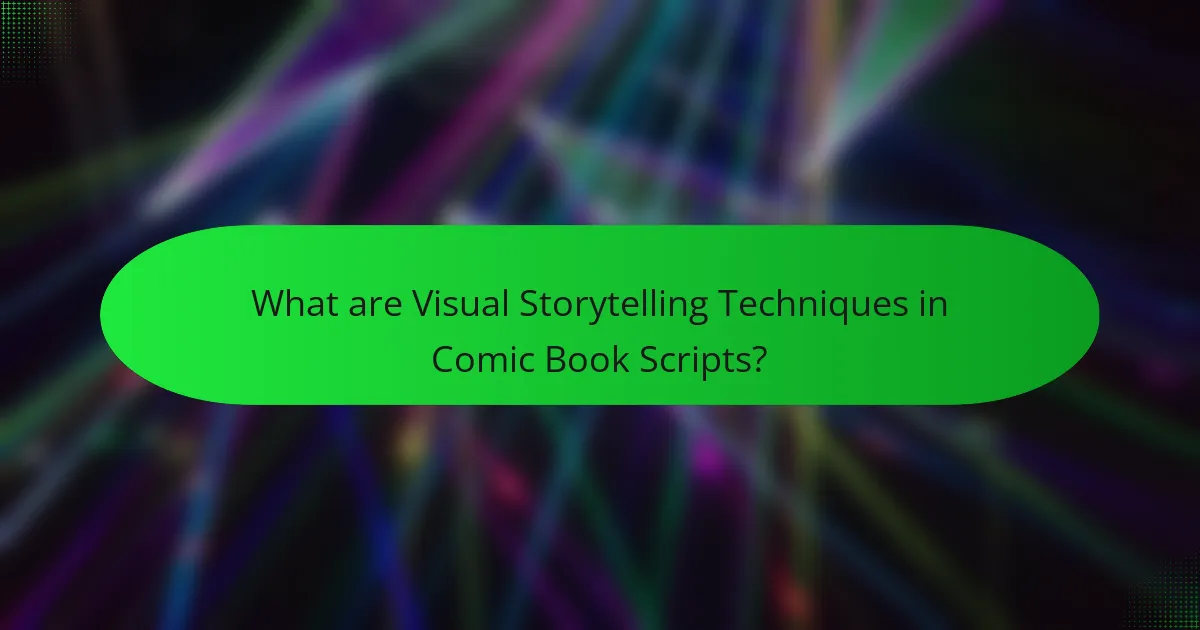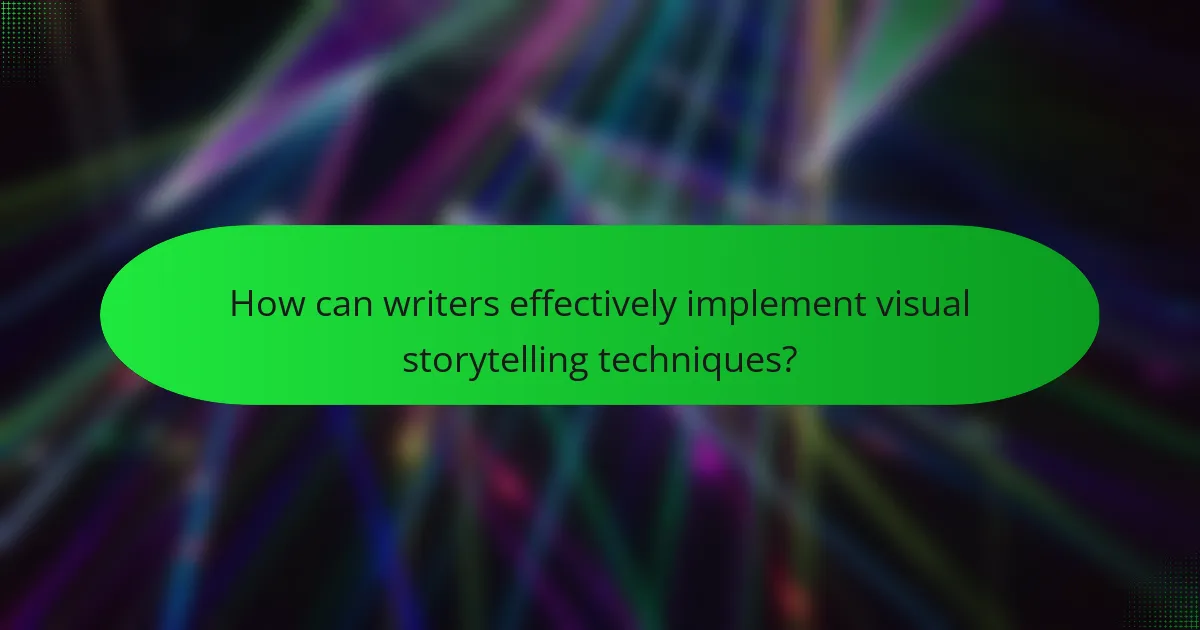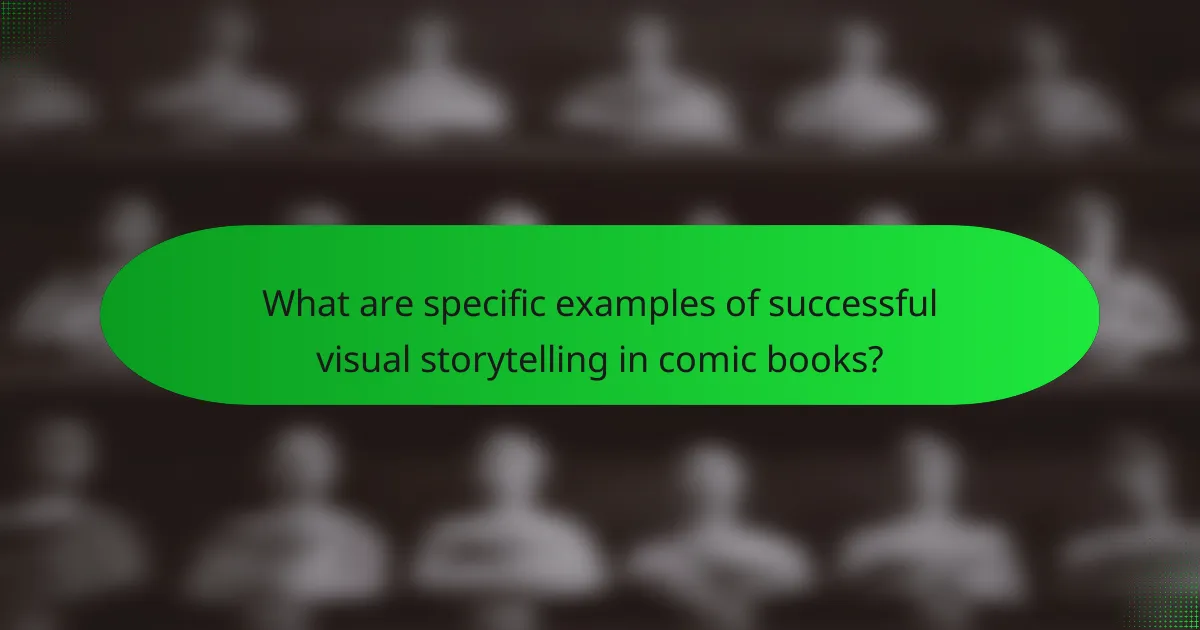Visual storytelling techniques in comic book scripts involve the strategic use of images and layout to convey narrative effectively. Key components include panel composition, pacing, visual metaphors, and the use of color and line work, all of which contribute to a cohesive narrative experience. This article explores how writers can implement these techniques to enhance storytelling, focusing on impactful visuals, pacing through panel layouts, and the emotional resonance of visual metaphors. Notable examples from acclaimed works like “Watchmen,” “Maus,” and “Saga” illustrate the power of visual storytelling in engaging readers and deepening narrative impact. Research indicates that effective visual elements significantly improve reader retention and understanding in comics.

What are Visual Storytelling Techniques in Comic Book Scripts?
Visual storytelling techniques in comic book scripts involve using images and layout to convey narrative. These techniques include panel composition, pacing, and visual metaphors. Panel composition determines how scenes are framed and how characters are positioned. Pacing is controlled through the number and size of panels, influencing the speed of the story. Visual metaphors enhance emotional depth by symbolizing themes or character emotions. Additionally, the use of color and line work can convey mood and tone. These elements work together to create a cohesive narrative experience that engages readers.
How do visual storytelling techniques enhance narrative in comic books?
Visual storytelling techniques enhance narrative in comic books by creating dynamic visual experiences. These techniques include panel layout, color usage, and visual pacing. Panel layout guides the reader’s eye and influences the story’s flow. For example, varying panel sizes can signify moments of tension or action. Color usage sets the mood and evokes emotional responses. Bright colors may indicate joy, while darker tones can suggest despair. Visual pacing, determined by the arrangement of panels, affects how quickly or slowly the story unfolds. A rapid sequence of panels can create urgency, while wider panels allow for reflection. Research shows that comics engage readers through a combination of text and imagery, enhancing comprehension and retention of the narrative. This integration of visuals and storytelling techniques makes comic books a unique and powerful medium for narrative expression.
What elements are essential for effective visual storytelling?
Effective visual storytelling requires a combination of key elements. These elements include a strong narrative, compelling characters, and engaging visuals. The narrative provides the framework for the story, guiding the audience through the plot. Compelling characters create emotional connections, making the story relatable and memorable. Engaging visuals, such as dynamic artwork and thoughtful layouts, enhance the storytelling experience. Additionally, the use of color and composition can evoke specific emotions and set the tone. Each of these elements works together to create a cohesive and impactful visual narrative.
How do visual cues influence reader perception and engagement?
Visual cues significantly influence reader perception and engagement by guiding attention and conveying meaning. They can enhance understanding through imagery, color, and layout. For example, bright colors often evoke emotions and can draw readers to key elements. Research indicates that visual storytelling increases retention of information by up to 65%. Additionally, well-placed visuals can break up text, making content more digestible. This keeps readers engaged longer and encourages interaction with the material. Studies show that comics utilizing strong visual cues can improve narrative comprehension and enjoyment.
Why is integrating visual storytelling important for comic book writers?
Integrating visual storytelling is crucial for comic book writers because it enhances narrative engagement. Visual elements complement written dialogue, creating a richer experience. Readers process images faster than text, facilitating quicker comprehension of the story. This synergy between visuals and text helps convey emotions and themes effectively. Research shows that comics combine visual and verbal elements, improving retention and understanding. A study by the University of Dundee found that readers remember information better when presented visually. Therefore, effectively integrating visual storytelling is essential for impactful comic book narratives.
What are the advantages of using visual storytelling techniques?
Visual storytelling techniques enhance communication and engagement. They simplify complex ideas through imagery. This approach captures audience attention effectively. Research shows visuals increase retention rates by 65% compared to text alone. Visuals evoke emotions, making narratives more relatable. They also facilitate quicker comprehension of information. Additionally, visual storytelling fosters creativity in content creation. Overall, these techniques improve the overall impact of the narrative.
How can visual storytelling impact character development?
Visual storytelling significantly impacts character development by providing immediate emotional context. It uses imagery to convey complex emotions that words alone may not express. For example, a character’s [censured] expressions or body language can reveal their internal struggles. This visual representation enhances audience understanding of character motivations. Research shows that visual cues can evoke stronger emotional responses than text-based descriptions. A study published in the journal “Cognitive Science” indicates that visuals aid memory retention, making character traits more memorable. Thus, effective visual storytelling deepens audience engagement with characters.
What challenges do writers face when integrating visual storytelling?
Writers face several challenges when integrating visual storytelling. One major challenge is the need to balance text and imagery. Writers must ensure that their scripts complement the visuals without overwhelming them. Additionally, writers often struggle with pacing. Visual storytelling requires a different rhythm compared to traditional writing. Another challenge is conveying emotions through visuals. Writers must rely on artists to interpret emotional nuances effectively. Collaboration is also a significant hurdle. Writers and artists must communicate clearly to align their creative visions. Furthermore, writers need to consider the audience’s interpretation. Visual elements can be subjective, leading to varied interpretations of the story. Lastly, technical limitations can pose challenges. Writers must be aware of the medium’s constraints, such as panel layout and color choices. These factors complicate the integration of visual storytelling in comic book scripts.
How can writers overcome common obstacles in visual storytelling?
Writers can overcome common obstacles in visual storytelling by focusing on clarity, pacing, and visual coherence. Clarity ensures that the story is easily understood by the audience. Writers should use straightforward language and avoid complex narratives that may confuse readers. Pacing is crucial for maintaining engagement. Writers can achieve effective pacing by balancing dialogue and visual elements. Visual coherence helps in creating a unified look and feel. Consistent character designs and color schemes contribute to this aspect. Additionally, incorporating feedback from artists can enhance the visual narrative. Research shows that successful comic books often prioritize these elements to create compelling stories.
What tools or resources assist in the integration process?
Storyboarding software assists in the integration process of visual storytelling techniques. Tools like Storyboard That and Toon Boom facilitate visual planning. These platforms allow creators to map out scenes visually. They help in organizing narrative flow and pacing. Graphic design software, such as Adobe Illustrator, enhances visual elements. Resources like online workshops provide guidance on techniques. Books on comic scripting offer structured insights into integration. These tools and resources collectively support effective storytelling in comic book scripts.

How can writers effectively implement visual storytelling techniques?
Writers can effectively implement visual storytelling techniques by utilizing imagery that enhances narrative. This includes selecting impactful visuals that complement the story’s themes. Writers should also focus on pacing through panel layouts, guiding the reader’s eye. Incorporating visual metaphors can deepen the narrative’s emotional resonance. Additionally, using color schemes can evoke specific moods and highlight key moments. Dialogue should be concise, allowing visuals to take center stage. Research shows that visual elements significantly improve reader engagement in comics. A study by the University of Dundee found that visual storytelling increases retention and understanding of content.
What are the best practices for incorporating visuals into scripts?
Incorporating visuals into scripts enhances storytelling and engagement. Use clear descriptions to guide artists on visual elements. Specify the mood and tone to align visuals with the narrative. Break down scenes into panels for better pacing and flow. Indicate character emotions through visual cues in the script. Reference existing artwork for style consistency. Ensure that visuals serve the story, not distract from it. These practices lead to a cohesive and compelling comic book narrative.
How should writers balance text and visuals for maximum impact?
Writers should balance text and visuals by ensuring that each complements the other effectively. Text should convey essential dialogue and narrative elements. Visuals should enhance the storytelling by providing context and emotional depth. For maximum impact, writers can use visuals to show action and setting, allowing text to focus on character thoughts and dialogue. This approach keeps the reader engaged without overwhelming them with information. Research indicates that effective visual-text integration can improve comprehension and retention. A study by Mayer (2001) found that multimedia learning is enhanced when visuals and text are well-aligned. Therefore, strategic placement of text and visuals is crucial for impactful storytelling in comic book scripts.
What role does pacing play in visual storytelling?
Pacing in visual storytelling controls the rhythm and flow of the narrative. It determines how quickly or slowly the story unfolds. Effective pacing enhances emotional engagement by allowing moments of tension or relief. For instance, quick pacing can create excitement during action scenes. Conversely, slower pacing can build suspense or deepen character development. Research shows that pacing influences audience retention and comprehension. According to a study by the University of Southern California, optimal pacing improves viewer satisfaction. This demonstrates that pacing is crucial for effective visual storytelling.
What types of visual storytelling techniques can be used in comic book scripts?
Comic book scripts can utilize various visual storytelling techniques. These include panel layout, which determines the arrangement of images and text. The use of color can evoke emotions and set the tone. Visual pacing influences the speed at which a story unfolds through the size and number of panels. Character expressions convey emotions and reactions effectively. Background details provide context and enrich the narrative. Symbolism can add deeper meaning to visuals. Transitions between panels guide the reader through the story. These techniques enhance engagement and comprehension in comic book storytelling.
How do different panel layouts affect storytelling?
Different panel layouts significantly influence storytelling in comics. They control pacing, focus, and emotional impact. For instance, larger panels can emphasize key moments, creating a sense of importance. Conversely, smaller panels can quicken the pace, conveying urgency or action.
Layouts that vary in shape can also guide the reader’s eye and create visual rhythm. A grid layout offers clarity and structure, while irregular layouts can evoke chaos or tension. The arrangement of panels can dictate how a story unfolds, allowing for simultaneous actions or flashbacks.
Research shows that panel arrangement can affect reader engagement and comprehension. A study by McCloud in “Understanding Comics” highlights how visual flow impacts narrative interpretation. Thus, the choice of panel layout is crucial in shaping the overall storytelling experience.
What are the effects of color and shading on mood and tone?
Color and shading significantly affect mood and tone in visual storytelling. Warm colors like red and orange evoke feelings of excitement and passion. In contrast, cool colors such as blue and green can create calmness or sadness. Shading adds depth and dimension, influencing how light interacts with colors. High contrast can generate drama, while soft shading can evoke gentleness. Studies show that colors can trigger emotional responses, impacting viewer engagement. For example, a 2018 study by K. H. K. S. et al. found that color choices directly influence emotional perception in visual media. Thus, careful selection of color and shading is essential in comic book scripts to convey the intended mood effectively.

What are specific examples of successful visual storytelling in comic books?
“Watchmen” by Alan Moore and Dave Gibbons exemplifies successful visual storytelling. The use of non-linear narrative and detailed artwork enhances character depth. “Maus” by Art Spiegelman effectively conveys complex themes through its anthropomorphic characters. The visual representation of Holocaust experiences resonates emotionally with readers. “Sandman” by Neil Gaiman utilizes diverse artistic styles to reflect different story arcs. This variation enriches the narrative experience. “Saga” by Brian K. Vaughan and Fiona Staples combines imaginative visuals with relatable themes. The artwork complements the storytelling, creating an immersive world. “Persepolis” by Marjane Satrapi employs stark black-and-white visuals to depict personal and political narratives. This approach emphasizes emotional impact and cultural context.
How have notable comic book authors utilized visual storytelling techniques?
Notable comic book authors have utilized visual storytelling techniques by integrating imagery with narrative elements. They employ panel layouts to control pacing and emphasize key moments. For example, Art Spiegelman in “Maus” uses contrasting visuals to convey complex emotions. Similarly, Scott McCloud outlines the importance of visual icons in “Understanding Comics.” Authors like Frank Miller utilize stark contrasts and dynamic angles to enhance action sequences. Additionally, sequential art allows for non-linear storytelling, as seen in “Watchmen” by Alan Moore. These techniques create a rich, immersive experience that engages readers on multiple levels.
What lessons can be learned from acclaimed comic book scripts?
Acclaimed comic book scripts teach valuable lessons in visual storytelling. They emphasize the importance of pacing to maintain reader engagement. Effective scripts balance dialogue with visual elements to convey emotions. Strong character development is essential for creating relatable protagonists. Clarity in panel descriptions enhances the artist’s interpretation. Use of subtext can deepen narrative complexity. Successful scripts often incorporate thematic consistency throughout the story. Finally, innovative panel layouts can enhance storytelling dynamics and surprise the reader.
How do visual storytelling techniques differ across genres?
Visual storytelling techniques vary significantly across genres. In comics, genres like superhero often emphasize dynamic action and vibrant colors. This approach engages readers through visually striking panels that convey movement. Conversely, horror genres utilize shadows and muted colors to create tension. These techniques evoke fear and suspense through visual cues. In romance comics, softer color palettes and close-up character expressions enhance emotional connections. This fosters intimacy between characters and readers. Furthermore, fantasy genres often incorporate elaborate world-building through detailed backgrounds. This immerses readers in fantastical settings. Each genre employs distinct visual elements to communicate its themes effectively.
What tips can help writers improve their visual storytelling skills?
Writers can improve their visual storytelling skills by focusing on clarity, imagery, and pacing. Clarity involves using concise language to convey ideas effectively. Imagery requires writers to paint vivid pictures with words, enhancing the reader’s imagination. Pacing is crucial in maintaining the flow of the story and keeping the audience engaged.
Additionally, studying visual media can provide insights into effective storytelling techniques. Analyzing comics and films helps writers understand how visuals complement narratives. Practicing storyboarding can also aid in visualizing scenes before writing. Collaborating with artists can enhance the writer’s ability to convey visual elements more effectively.
Research indicates that visual storytelling techniques can significantly enhance reader engagement and comprehension. According to a study by Mayer (2009), integrating visuals with text improves retention and understanding. These strategies collectively help writers refine their visual storytelling capabilities.
How can writers practice and refine their visual storytelling techniques?
Writers can practice and refine their visual storytelling techniques by engaging in focused exercises. They can analyze existing comic book scripts to understand visual pacing and panel layout. Creating storyboards for their narratives helps visualize scenes effectively. Writers should also experiment with different art styles to convey emotions. Collaborating with artists can provide insights into visual interpretation. Participating in workshops focused on visual storytelling enhances skills through feedback. Additionally, reading books on visual narrative techniques offers theoretical knowledge. Regularly practicing these methods leads to improved storytelling proficiency.
What resources are available for learning more about visual storytelling in comics?
Books on visual storytelling in comics include “Understanding Comics” by Scott McCloud. This book provides foundational knowledge about the medium. Online courses are available on platforms like Coursera and Skillshare. These courses often feature industry professionals teaching key concepts. Websites such as Comic Book Resources and The Beat offer articles and interviews. These resources provide insights from experienced comic creators. Additionally, local comic shops may host workshops. These workshops often focus on storytelling techniques.
Integrating visual storytelling techniques in comic book scripts is essential for enhancing narrative engagement and reader comprehension. This article explores key elements such as panel composition, pacing, visual metaphors, and the impact of color and layout on mood and tone. It addresses the challenges writers face in balancing text and visuals, as well as strategies to overcome these obstacles. Additionally, it highlights the importance of effective pacing and provides resources for writers to refine their visual storytelling skills. Examples of successful visual storytelling in notable comic works are also discussed, showcasing the effectiveness of these techniques across different genres.